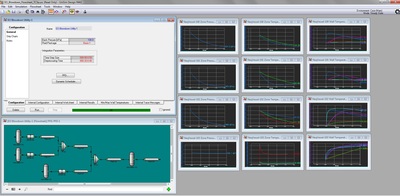
Contact Details:
Honeywell Automation and Control Solutions SA (Pty) Ltd
Honeywell House Waterfall Park
Bekker Street (Treur close)
Midrand
Johannesburg
Gauteng
1685
South Africa
Tel: +27 11 695 8000
Fax: +27 (0)800 982 277
Send Enquiry | Company Information

HONEYWELL ANNOUNCES NEW UNISIM DESIGN UTILITY FOR SAFER OIL AND GAS OPERATIONS
Product News Tuesday, November 3, 2015: Honeywell Automation and Control Solutions SA (Pty) Ltd
UniSim Design Blowdown Utility Helps Increase Safety, Cut Costs for New and Existing Installations
HOUSTON, Oct. 21, 2015 – Honeywell (NYSE: HON) Process Solutions (HPS) announced today a key enhancement to its UniSim® design and simulation software designed to help manufacturing facilities improve safety and reduce capital expenditures for both new and existing installations.
The new UniSim Design Blowdown Utility, designed specifically for oil and gas, petrochemical, and chemical industry applications assists in designing systems to allow for safe depressurization of process equipment. It also helps companies manage capital costs by more accurately selecting the right construction materials and blowdown system sizes needed for the site.
“We developed this new utility in-house based on Honeywell’s decades of industry expertise, which allows us to perpetuate our tradition of best-in-class customer support, after market services and smooth implementation” said Mike Brown, Honeywell Marketing director. “This will play a critical role to help improve the safety of the world’s oil and gas installations, refineries, petrochemical and chemical plants.”
Understanding depressurizing behavior in a blowdown system is critical to the function of the system and ultimately the safety of the facility and employees. Rapid depressurizing and gas expansion can result in very low temperatures, potentially putting equipment at risk of brittle fracture if the construction material goes below its ductile-brittle transition temperature. In addition, the entire pressure relief system, including safety valves, relief orifices, flare piping and knockout drums, must be sufficiently sized to handle the flowrates that occur during blowdown, in addition to the piping and capacity of the flare system.
For new constructions, an accurate prediction of the minimum vessel wall temperature during blowdown is important for the selection of the appropriate construction material, for the elimination of overdesign and with the additional benefit of lowering project costs. Similarly, having an accurate prediction of the maximum flow rate during blowdown is important for the reduction of overdesign associated with the relief valve/network sizing, without compromising on safety. For existing facilities, blowdown studies can prompt for changes in operating procedures, process equipment material or capacity in order to avoid brittle fracture during blowdown.
After introducing the first commercial non-equilibrium blowdown utility in 2013, Honeywell has continued to innovate with further first-to-market capabilities for flow-sheeting, blowdown scheduling, and two dimensional wall heat-transfer for vessels.
UniSim Design achieves improved fidelity by using a modeling approach consistent with the new recommended practices and analytical fire method set forth in the Sixth Edition (Jan 2014) of the API Standard 521 Pressure-relieving and Depressuring Systems. Validation tests show that the UniSim Design Blowdown Utility matches experimental data from publically-available and proprietary sources, with the desired accuracy for blowdown prediction.
A free trial of UniSim Design is downloadable here. To learn more about Honeywell Process Solutions products, visit www.honeywellprocess.com.
Honeywell Performance Materials and Technologies (PMT) is a global leader in developing advanced materials, process technologies and automation solutions. PMT’s Advanced Materials businesses manufacture a wide variety of high-performance products, including environmentally friendlier refrigerants and materials used to manufacture end products such as bullet-resistant armor, nylon, computer chips and pharmaceutical packaging. Process technologies developed by PMT’s UOP business (www.uop.com) form the foundation for most of the world’s refiners, efficiently producing gasoline, diesel, jet fuel, petrochemicals and renewable fuels. PMT’s Process Solutions business (www.honeywellprocess.com) is a pioneer in automation control, instrumentation and services for the oil and gas, refining, pulp and paper, industrial power generation, chemicals and petrochemicals, biofuels, life sciences, and metals, minerals and mining industries.
Honeywell (www.honeywell.com) is a Fortune 100 diversified technology and manufacturing leader, serving customers worldwide with aerospace products and services; control technologies for buildings, homes, and industry; turbochargers; and performance materials. For more news and information on Honeywell, please visit www.honeywellnow.com.
This release contains certain statements that may be deemed “forward-looking statements” within the meaning of Section 21E of the Securities Exchange Act of 1934. All statements, other than statements of historical fact, that address activities, events or developments that we or our management intends, expects, projects, believes or anticipates will or may occur in the future are forward-looking statements. Such statements are based upon certain assumptions and assessments made by our management in light of their experience and their perception of historical trends, current economic and industry conditions, expected future developments and other factors they believe to be appropriate. The forward-looking statements included in this release are also subject to a number of material risks and uncertainties, including but not limited to economic, competitive, governmental, and technological factors affecting our operations, markets, products, services and prices. Such forward-looking statements are not guarantees of future performance, and actual results, developments and business decisions may differ from those envisaged by such forward-looking statements. We identify the principal risks and uncertainties that affect our performance in our Form 10-K and other filings with the Securities and Exchange Commission.
